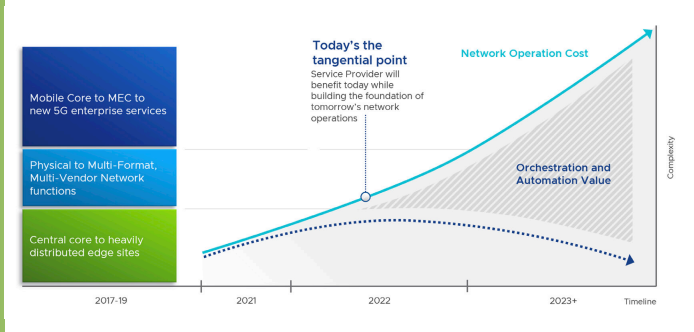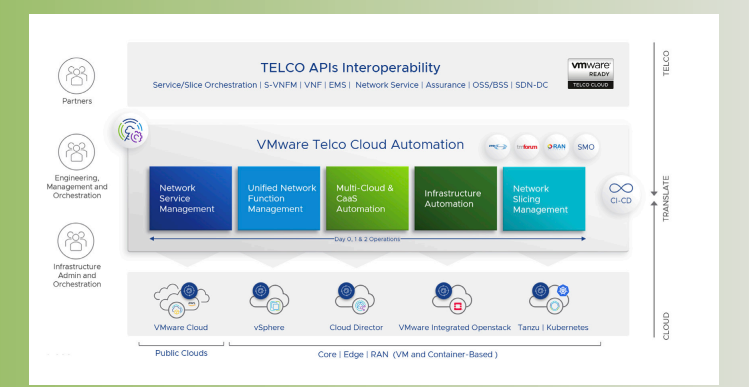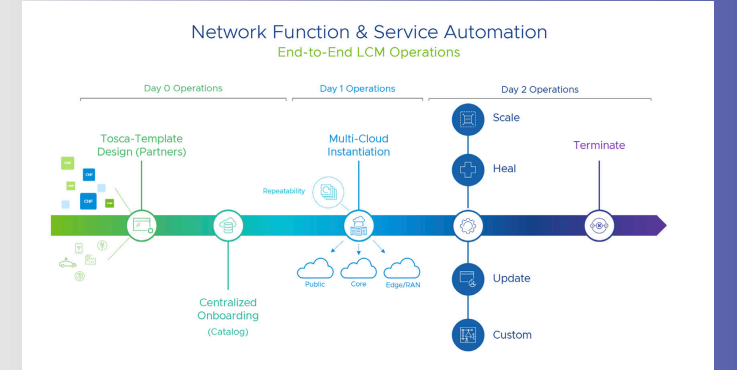Communications service providers’ (CSPs) transition from physical to multi-cloud networks is driven by the promises of enhanced service experience, complete resilience, operational agility, and optimised capital expenditure. It is a radical departure from the traditional single-purpose hardware appliances model. CSPs therefore must now design and operate their service deliveries across a web of data centres, bridging physical and virtual ecosystems while enabling interoperability across a more diverse multi-vendor ecosystem. Here, VMware considers the intensive tasks for coordinating virtual and cloud network functions (VNFs and CNFs collectively termed xNFs), combined with the design and management of services. An automated approach, in the form of orchestration, that abstracts the multi-cloud complexity and removes tedious manual tasks is mandatory to achieve the telco cloud’s expected efficiencies.
Achieving effective automation requires holistic support of network functions and the services lifecycle from their creation to their termination – creation, onboarding, installation/configuration, start/ stop, scaling, monitoring/diagnosis, reconfiguration, healing and updating. To perform these activities, an orchestrator must interoperate with several other components of the modern network architecture – Kubernetes, VIM, EMS, VNF-M, OSS/BSS and service assurance. Using vendor-neutral standards, such as ETSI-MANO, TMF and O-RAN, is crucial to successfully coordinate the various components of this architecture while protecting CSPs from potential vendor lock-in issues. Since late 2013, CSPs have been deploying NFV in production. Mature standardised solutions, such as management and orchestration (MANO), however, have not yet been widely available or used. Many of the current deployments struggle with a lack of interoperability across the various vendors, which paves the way for half-baked solutions requiring major service integration fees and, consequently, delaying roll-outs of virtual based services.
Market dynamics
Most vendors in the automation and orchestration market are either network equipment providers (NEPs) or operations/business support system (OSS/BSS) providers that typically propose a top-down or blueprint-first approach to orchestration and whose solutions primarily work in siloed stacks. These approaches do not consider the complexity and rapid evolution of cloud technologies, which can create continuous integration challenges or deficient onboarding, placement and management processes.
Network transformation is well underway, which affects all layers of service delivery. Transformation can offer opportunities, but also present fast-paced changes which require new mindsets, skills, practices and solutions. As CSPs rapidly try to adapt to these changes, the complexity of their operations increases exponentially with each change – from infrastructure to multi-cloud and containers-as-a-service (CaaS) management to network functions, services and network slicing.
As the cloud gains in importance in the service delivery, there are massive multi-layer innovations starting from infrastructure to applications to the service layer. A clear innovation is the transition from a central or regional core data centre to a highly distributed cloud ecosystem, including near and far edges – and even traditional public clouds or IT for certain types of workloads. There exists a transition from only a few data centres to hundreds and more, designed with fragmented technologies such as heterogenous VIM and Kubernetes. Coupled with those changes is the multiplication of multi-vendor network functions and enterprise applications running on VMs and containers. Some networks are already supporting thousands of xNFs, but the overall market is still nascent.
CSPs understand that orchestration and automation must be implemented at the heart of any service delivery to mitigate the network transformation operational impacts with leaner processes that scale. Automation and orchestration are the right answers to enable organisations to innovate while controlling the costs of these rapid and disruptive advances. Now CSPs are beginning to see the value in their operations to curb the complexity and cost curve (see Figure 1).

CSPs benefit today by implementing these capabilities – those benefits will only increase as the virtualisation footprint grows. CSPs that wait to orchestrate and automate their networks, on the other hand, will miss revenue-generating opportunities and see costs and complexities increase. It comes as no surprise, then, that by 2024 according to Appledore Research the global service orchestration market will reach US$1.9bn, at 93.2% CAGR.1
When developing an effective automation and orchestration solution, it is essential to keep in mind that CSPs globally find themselves at different stages of network maturity. As such, the ideal automation solution can manage 4G, VNF-based networks, help a CSP graduate to 5G, CNF-based networks and, for those CSPs that already operate with 5G, cloud-native networks, support cutting-edge automation, such as network slicing to unlock new revenue sources. An effective automation solution must support both VNF and CNF-based workloads and help carry a CSP from 4G to 5G in a way that minimises network disruption and opens avenues to reduce costs and bolster revenues. In other words, the path to network modernisation does not only lie in constructing features to address tomorrow’s requirements, but one that can provide end-to-end management, automation and orchestration for many of today’s 4G-based requirements as well.
With this mindset, VMware built VMware Telco Cloud Automation – a product that provides extensive network automation for 4G and 5G-based networks. VMware began its journey with Telco Cloud Automation in 2016 by assessing the market, listening to CSPs and launching as an orchestrator to address 4G deployments and VNF management. VMware’s findings were twofold: first, CSPs must implement orchestration and automation as soon as possible to improve efficiency and ensure readiness for modern cloud network innovations. Second, most of the existing solutions on the market were designed around CSP vendors’ vantage points with traditional drawbacks such as vendor lock-in and heavy integration costs.
These solutions all shared a fundamental flaw: none have fully taken advantage of the cloud’s capabilities over time, nor have they tapped into possibilities associated with multi-cloud deployments. To address these pain-points, VMware applied its cloud expertise and proposed a new cloud-smart approach to orchestration – a strategy that abstracted much of the cloud complexities and exposed the new multi-cloud ecosystem through standard CSP interfaces, such as ETSI and TMF. The pith of this approach was VMware’s ability to build native integrations at each layer and to continuously synchronise the south-bound infrastructure stack – VIM/CaaS/IaaS – with the upper service and application management stack of NFVO/xNFM/EMS/SOM/xAPPs/rAPPs. VMware, in short, constructed an automation solution that addressed the immediate needs of CSPs, while also enabling a path for future network growth and development.
How does effective xNF management create a modern, monetisable network?
VMware Telco Cloud Automation is a multi-domain, multi-layer automation and orchestration platform that accelerates time-to-market of communication services while igniting operational agility through unified automation across networks and clouds. It delivers modern, multi-cloud automation for each layer of the telco cloud – from infrastructure to xNFs to network service and slicing – and streamlines the CSPs’ end-to-end automation journey (see Figure 2).

Building from its original bread-and-butter capabilities, VMware Telco Cloud Automation offers robust management of network functions through a generic network function manager (G-VNFM) that unifies and standardises the lifecycle management of network functions across hybrid technologies, including VNFs and CNFs from a host of network function vendors, as depicted in Figure 3. This automation layer allows for easy onboarding and instantiation of new network functions and the corresponding lifecycle management of their Day 0 to Day 2 operations. This layer also permits additional CNF-based automation, such as late-binding for Kubernetes nodes customisation.

VMware Telco Cloud Automation’s xNF management capabilities are both fundamental for any network seeking comprehensive VNF management or for those striving for CNF deployments. Below we present capabilities central to VMware Telco Cloud Automation’s xNF automation layer to illustrate how its features enable seamless workload deployments for any network at any stage of maturity. For more on VMware’s late-binding capability.
Design network functions and services through an easy-to-use visual composer. The visual composer provides an end-to-end environment to design new or modify existing ETSI-MANO compliant TOSCA templates. The network function template integrates elements such as VDU, HELM, network, resources, automation interfaces, and other artifacts.
Easily onboard network functions and services. Telco Cloud Automation enables onboarding of SOL001/004-compliant network functions and services. Telco Cloud Automation provides a simple UI for network function onboarding in few easy steps. Since most of the network functions have been certified through VMware Ready for Telco Cloud2 before being onboarded, it ensures smoother implementation and artifacts compliance. Once onboarded, the network functions and services are added to their respective catalogues for review and instantiation.
Access all network functions and services in a single location. The centralised catalogues offer access to all onboarded xNFs including those onboarded using Telco Cloud Automation and others managed through third-party S-VNFM.
Intent-based placement (cloud-smart). Continuous synchronisation between Telco Cloud Automation and the VIM/Kubernetes clusters enables effective intent-based placement. Telco Cloud Automation automatically optimises workload placement on the most suitable cloud, matching the descriptor requirements with the cloud profiles – limiting possible rollbacks and allowing for more dynamic management of the application and cloud resources.
CNF, VM and Kubernetes node customisations. In line with the notion of intent-based placement and to solve a major industry problem related to CNF instantiation, Telco Cloud Automation automates the Kubernetes node customisations, in a process known as late-binding. Late-binding addresses a fundamental issue for network operators: how to balance a set of heterogeneous vRAN and 5G core vendor requirements with consistent operations. Telco Cloud Automation’s late-binding configures cloud resources on-demand based on the network function requirements and then (re)applies these configurations during cluster scale-out or upgrades.
Automated lifecycle management. Telco Cloud Automation offers automation capabilities driven by a workflow engine that executes operations described in VNFD and NSD, plus custom-defined workflows. These policies apply to the entire lifecycle management (Days 0 – 2 operations) of network functions and services for lean operational processes. They also remove complicated, tedious and repetitive tasks while maximising overall resource utilisation through dynamic scaling and multi-cloud workload mobility.
The confluence of these features provides comprehensive xNF management for CSPs at any stage of network development – from those deploying 4G-based VNFs to those seeking hybrid xNF deployments to those entirely cloud-native. VMware Telco Cloud Automation serves as that unifying, multi-layer platform for CSPs on the journey to network modernisation. VMware Telco Cloud Automation’s xNF management also helps CSPs reduce costs and unlock incremental sources of revenue.
Telco Cloud Automation’s centralised and unified xNF management transforms traditional processes and reduces manual tasks required at the network layers – improving efficiency of Day 0 – Day 2 operations and reducing opex. xNF automation is also a key factor in improving network and service resiliency and reducing mean time to repair (MTTR). These improvements lead directly to an improved customer experience, which allows CSPs to meet and exceed increasingly stringent service level agreements (SLAs) – opening additional sources of revenue. This improved customer experience offers better quality of service, bolsters customer satisfaction and SLA adherence, resulting in additional revenues, market share and reduced customer churn.
Network automation and orchestration are key components to supporting CSPs at any stage of workload deployment – from 4G-based VNFs, to hybrid xNFs to pure 5G-based CNFs. What’s more, VMware’s Telco Cloud Automation support for 4G and 5G-based workloads can – through easy onboarding, instantiation and centralised lifecycle management – walk a CSP through network modernisation efforts, all while reducing costs and opening new revenue sources.
Comment on this article below or via Twitter: @VanillaPlus OR @jcvplus






